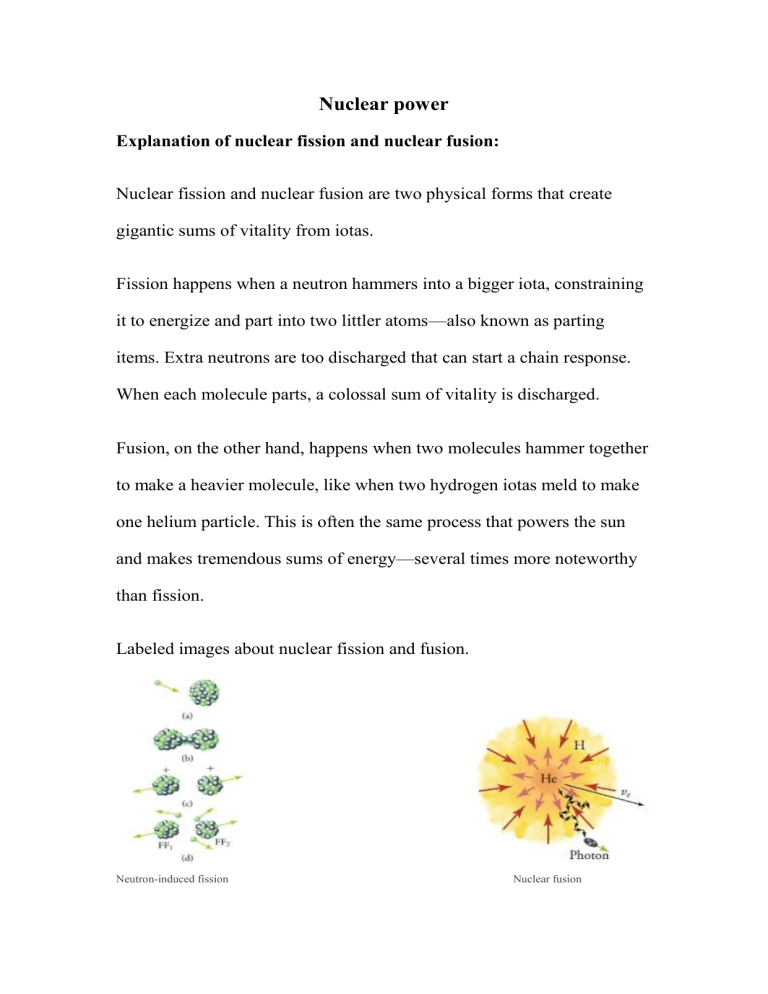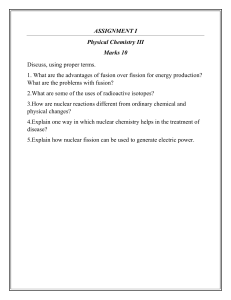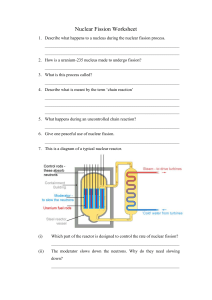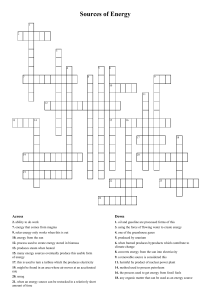
Nuclear power Explanation of nuclear fission and nuclear fusion: Nuclear fission and nuclear fusion are two physical forms that create gigantic sums of vitality from iotas. Fission happens when a neutron hammers into a bigger iota, constraining it to energize and part into two littler atoms—also known as parting items. Extra neutrons are too discharged that can start a chain response. When each molecule parts, a colossal sum of vitality is discharged. Fusion, on the other hand, happens when two molecules hammer together to make a heavier molecule, like when two hydrogen iotas meld to make one helium particle. This is often the same process that powers the sun and makes tremendous sums of energy—several times more noteworthy than fission. Labeled images about nuclear fission and fusion. Neutron-induced fission Nuclear fusion Difference and similarities: Nuclear fission and nuclear fusion are two distinct types of energy-releasing reactions that occur within the nucleus of an atom. Both reactions release energy from high-powered atomic bonds between particles within the nucleus. The primary difference between the two is that fission is the process of splitting an atom into two or more smaller ones, while fusion is the process of fusing two or more smaller atoms into a larger one. Fission requires a critical mass of the starting substance and high-speed neutrons, while fusion requires very high temperatures and high density of the starting substance. Fission does not usually occur in nature, while fusion occurs in stars like our sun. Fission is used in nuclear reactors to produce electricity, while fusion is still at the experimental stage: Two common nuclear isotopes: Hydrogen: Protium is the most common isotope of hydrogen, while deuterium and tritium are rare isotopes. Uranium-235: Uranium-235 is an isotope of uranium widely used for nuclear power generation and nuclear weapons fabrication. The physical properties of these two isotopes Protium: It is the foremost common isotope of hydrogen, with one proton and one electron. It has an nuclear number of 1, a mass number of 1, and a relative nuclear mass of 1.007825 g/mol. It incorporates a straightforward structure, with the electron within the 1s orbital around the core. It is the lightest and most inexhaustible component within the universe. It is utilized as a fuel for atomic combination reactors and as a tracer in chemical responses. Uranium-235: Uranium-235 is an isotope of uranium that produces up around 0.72% of common uranium 1. It is the as it were actually happening fissile fabric, meaning it can support a nuclear chain response 12. Uranium-235 includes a half-life of 703.8 million a long time. The discussion for the use of these two isotopes: Protium is utilized since it is plenteous and simple to get. On the other hand, Uranium-235 is the as it were normally happening that can support an atomic chain reaction. Characteristics of alpha particles, beta particles and gamma rays: Consists of Electric Charge Mass Speed Ionization Penetration Power Alpha Particles helium nucleus +2 7350 < 2.0 x107m/s strong skin or paper Here are images showing them: Beta Particles electron/positron -1 /+1 1 < 2.9 x108m/s weaker few sheets of Al Gamma Rays photon 0 0 3.0 x108m/s weakest few cm of Pb How nuclear power plants generates energy: Nuclear power plants generate electricity through a process called nuclear fission. The process involves splitting the nucleus of an atom, which releases a large amount of energy in the form of heat. This heat is then used to produce steam, which drives a turbine connected to a generator that produces electricity . Steps involved in generating electricity in a nuclear power plant: 1. Fuel Handling: The fuel utilized in atomic control plants is uranium, which is prepared into little pellets and stacked into fuel rods. These fuel bars are at that point put into the reactor center. 2. Heat Generation: The fuel rods are bombarded with neutrons, which separate the uranium atoms in a process called fission. This process releases tremendous power. 3. Heat Transfer: The heat created by the process is utilized to bubble water, which vaporizes water. 4. Turbine Operation: The steam produced is used to turn a turbine, which drives a generator that produces electricity. 5. Cooling: After the steam has passed through the turbine, it is cooled and condensed back into water, which is then pumped back into the reactor core to repeat the process. The societal and environmental impact: Societal Benefit: Nuclear plants need a lot of employees and all sorts of workers to run, so they can create numerous and various job opportunities for the society. Societal Risk: Nuclear energy has several risks associated with it. One of the most significant risks is the potential for accidents or disasters, which can release radioactive materials threatening the public health. Environmental Benefit: Nuclear energy can help reduce carbon emissions and avoid harmful emissions that cause smog and acid rain, which are big threats for the natural environment. Environmental Risk: the biggest problem is radioactive waste, which can remain radioactive and dangerous to human health for thousands of years. The storage facilities for radioactive waste could leak, crack, or erode, contaminating the soil and groundwater near the facility and leading to serious health problems for people and organisms in the area. Personal response: In my opinion, as a society, we should encourage the use of more nuclear energy while also taking steps to mitigate the risks associated with it. Nuclear energy has several advantages, including its ability to generate large amounts of electricity without producing greenhouse gases or other pollutants. It is also a reliable source of energy that can help reduce our dependence on fossil fuels and other non-renewable sources of energy. In conclusion, I believe that as a society, we should encourage the use of more nuclear energy while also taking steps to mitigate the risks associated with it. By doing so, we can help reduce our dependence on fossil fuels and other non-renewable sources of energy while also protecting public health and the environment. Hydroelectricity and wind power for energy: Hydroelectricity and wind power are two renewable energy sources that are used to generate electricity.: Hydroelectricity Hydro-electricity is a form of renewable energy that uses the power of moving water to generate electricity. The following energy transformations take place in using hydroelectricity: Water gains potential energy as it is stored behind a dam or flows uphill, and then loses potential energy and gains kinetic energy as it falls down. After that, water transfers kinetic energy to the blades of a turbine as it strikes them. Turbine converts kinetic energy into mechanical energy as it rotates. Finally, generator converts mechanical energy into electrical energy as it spins electromagnets and coils of wire. Wind Power Wind power is created using a wind turbine, a device that channels the power of the wind to generate electricity. T The following energy transformations take place in using wind power: Wind turns the propeller-like blades of a turbine around a rotor. Then, rotor converts kinetic energy into rotational energy. After that, shaft transfers rotational energy to the generator. Finally, generator converts rotational energy into electrical energy as it spins electromagnets and coils of wire. Resources: Fission and fusion: What is the difference?. Energy.gov. (n.d.). https://www.energy.gov/ne/articles/fission-and-fusion-what-difference Libretexts. (2020, December 10). 7.5: Nuclear fission and nuclear fusion. Chemistry LibreTexts. https://chem.libretexts.org/Courses/Portland_Community_College/CH105%3A _Allied_Health_Chemistry_II/07%3A_Nuclear_Chemistry/7.05%3A_Nuclear_ Fission_and_Nuclear_Fusion Admin. (2022, July 29). Protium - definition, symbol, Structure & properties with videos. BYJUS. https://byjus.com/chemistry/protium/ Nuclear 101: How does a nuclear reactor work?. Energy.gov. (n.d.-b). https://www.energy.gov/ne/articles/nuclear-101-how-does-nuclear-reactor-work Benefits of nuclear energy for the environment. enCore Energy. (2023, April 12). https://encoreuranium.com/benefits-of-nuclear/benefits-of-nuclear-energy-forthe-environment/ Nuclear energy. Home - National Geographic Society. (n.d.). https://www.nationalgeographic.org/encyclopedia/nuclear-energy/ U.S. Energy Information Administration - EIA - independent statistics and analysis. Nuclear power and the environment - U.S. Energy Information Administration (EIA). (n.d.). https://www.eia.gov/energyexplained/nuclear/nuclear-power-andthe-environment.php How hydropower works. Energy.gov. (n.d.-b). https://www.energy.gov/eere/water/how-hydropower-works Davis, B. (2022, July 3). Hydroelectric Power vs wind power. Energy Understood. https://energyunderstood.com/hydroelectric-power-vs-wind-power/ Max Boegl - Wind-hydro hybrid: Ge Renewable Energy. Max Boegl - Wind-hydro hybrid | GE Renewable Energy. (n.d.). https://www.ge.com/renewableenergy/stories/wind-hydro-hybrid-power


